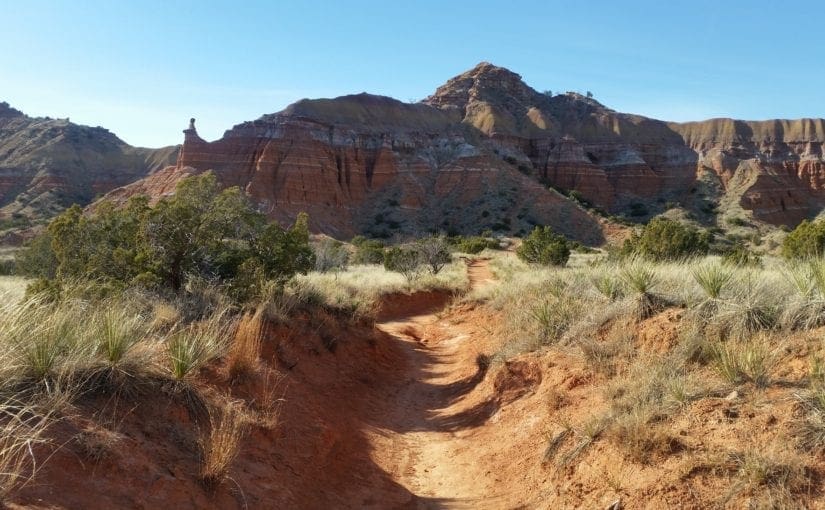Most recently updated January 16th, 2025
Summer is undeniably coming. I know this because the days have started getting the tiniest bit longer… 😉
Sadly, many of us emerge from Winter’s shapeless warm layers not as much the “beautiful butterfly” as we would like.

Each Spring, we feel the need to improve our weight and fitness before we can flutter confidently in the sunshine. Or even wear shorts….
(I don’t mean to suggest that anyone needs to be a certain size. It’s up to each individual and their medical advisors to decide what’s best for them.)
For myself, the main goal is to be fit enough to do any hike I’m interested in without a struggle.

Also, I want to buy clothes when I need something new, not because I’ve outgrown my current size.
Fortunately, it’s pretty easy to lose weight hiking and get more fit at the same time!
Why Hiking Is A Great Way to Get In Shape
The great thing about hiking is that pretty much anyone can do it, it doesn’t cost a lot of money, and it gets you outdoors.
Some of my posts contain affiliate links. If you make a purchase through an affiliate link, I will receive a small payment at no additional cost to you. I do not get paid for recommendations, all opinions on this site are my own. See full Disclosure page here.
Walking is a fantastic exercise too, but hiking is much more than just a walk, it also requires strength and balance. So what’s the difference?
-

Hiking is a great way to get fit and burn calories. Hiking involves walking over varied uneven terrain on natural trails – although urban hikes can also include greenways. Most hikers also carry a small day pack which also adds a little bit of weight.
- Hiking with a pack works every major muscle group in your body, building muscle tone, and improving your cardio fitness.
- Though you might think you’re only working your quads and glutes, hiking develops a strong sense of balance and powerful core muscles, too. Hiking with poles tones your arms as well.
Of course, you could also get this kind of workout at the local gym – but you can’t experience being outdoors in Nature while working out on an elliptical machine.
If you have allergies, you may have to workout in a filtered environment until whatever’s making you miserable passes. But when the air clears, you’ll be ready to hit the trail!
Get The FREE PDF!
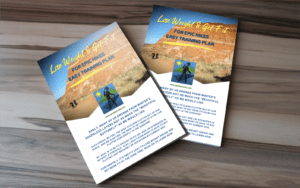 Everything that you need to start your hiking weight loss journey is included in this post.
Everything that you need to start your hiking weight loss journey is included in this post.
But it’s a long read and might be awkward to refer to while you’re training.
For your convenience,you can click here to sign up and download your FREE “Lose Weight and Get Fit” PDF file.
Then you can print it out and refer to your plan anytime you want. Happy training! LJ
6 Reasons Hiking Is Great for Weight Loss
Hiking is something you can do, in infinite variety, so you never get tired of it. Here are 6 more reasons why it’s a great exercise to lose weight:
- You hike in Nature, not stuck in a gym.
- It’s easy and inexpensive for almost anyone to start.
- Hiking works both cardio and muscle fitness.
- The more you hike, the more fit you get.
- You can change length, pace, and pack weight to vary your workout.
- It can burn massive mounts of calories
The best exercise is one you actually enjoy and will keep doing.
Hiking also has built-in goals (besides calorie burn) to keep you motivated, like getting fit enough to hike someplace epic like Patagonia, or more simply – to hike fast enough to make it back to your local trailhead by a certain time.
WHAT ABOUT MY DIET?

No discussion of weight loss would be complete without talking about diet.
I’m not a great believer in any diet where you substitute a shake or something pre-packaged for your own home cooking.
I don’t even want to have to measure servings or count calories, really.
Those activities are time-consuming, expensive, and stressful, and will ultimately fail. While you may actually lose some weight in the short term, eventually it will all come back.
This is because you have to learn cooking and eating habits that you can sustain over the long term. It’s important to find ways to enjoy healthy eating.
6 healthy diet guidelines:
- Get 30% of your daily calories from protein.
- Avoid processed foods – including soda and trans fats.
- Limit added salt, sugars, and sauces.
- Limit wheat, dairy and red meat.
- Eat veggies and fruits every day.
- Drink lots of water.

Eat a healthy, well-balanced diet 80 percent of the time.
The other 20 percent of the time, eat what you want.
Have a cookie. Drink a beer. Eat something deep-fried on a stick.
KEEP TRACK OF WHAT YOU EAT (AT FIRST)
When I’m working towards a weight loss goal, I simply write down what I eat each day. No one else sees this food journal – just me.

But there it is, staring me in the face, so if I’m not meeting my goals I can figure out why.
You could also use an app or online calculator to set calorie and protein goals and track your intake.
You should be consistent with your food tracking, but you don’t have to be a total perfectionist. If you eat at a restaurant, you can just estimate.
Food tracking becomes tedious almost immediately. So once you’ve got your new diet and eating habits wired in, you can stop.
DON’T COUNT CALORIES ON HIKE DAYS
You need energy from food to keep going, so eat what you need until you’re satisfied.

You’ll be ravenous on hike days. It’s to be expected when you’re working your butt off for hours at a time.
That said, don’t go completely off your eating guidelines.
Eat delicious, clean, balanced snacks like protein bars, nuts and dried fruit, to keep your mood and energy up.
Burn CALORIES Hiking
I don’t worry about calories when I’m hiking, because I’m almost certain to burn them all off.
Here’s an example of how many calories you can burn on the trail:
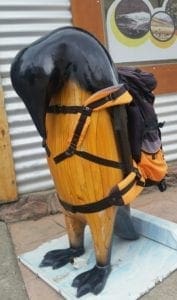
Using a Calorie Burn Calculator, putting in my height and weight, I determined that I would burn 1100 calories in three hours of hiking – and I’m not very large.
The larger your frame and heavier you are, the more calories you will burn.
Of course adding a pack (more weight) and more challenging terrain will burn even more calories.
Beginning Hiker’s 8-Week Training Program
You may already have a maintenance workout schedule going that keeps you in generally good shape. You can add to that or modify it to focus on areas that need building up for hiking.
Or if you’re just starting out, this is good training for hiking beginners. You can start at your own level and build from there.
For summer hikes, start building a good strength base early in the season.
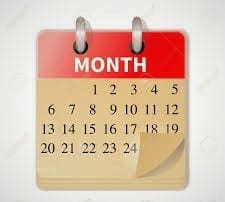
That would mean an early Spring start, for those who live where winter isn’t good for hiking. So if you start in April, you’ll be ready to go by June!
From week to week, you’ll build on the progress you’ve made in the previous weeks.
- Weeks 1-3: Strength-training 3 days per week, 1 hour/session.
- Weeks 4-6: Keep doing the Strength Training, and add one additional endurance workout every week for 45 minutes at moderate intensity (like jogging or hiking).
- Weeks 7-8: Continue Strength Training, increase the length of your weekly endurance workouts to 1.5 to 2 hours, and add 1 day of high-intensity exercise with high output but less weight (like speed hiking).
- Begin and end each workout with a 10 minute stretching routine.
So, at the end of the 8 weeks, your weekly training will include:
- (3) Strength training workouts,
- (2-3) 1.5-2 hour moderate endurance hiking or jogging workout, and
- (1) high intensity workout – like speed hiking.
- Stretch every day
| Sample Weekly Schedule | ||
| Monday | Strength | Stretch |
| Tuesday | Endurance | Stretch |
| Wednesday | Strength | Stretch |
| Thursday | Endurance | Stretch |
| Friday | Strength | Stretch |
| Saturday | Hi Intensity | Stretch |
| Sunday | (Endurance) | Stretch |
To see a complete detail of the hikes I did training for an epic trip to New Zealand, see my 8 Weeks to Awesome post.
You can also read my weekly Training Log posts for a blow-by-blow account of my progress. Hopefully they will inspire and encourage you! 🙂
Okay – so anyway, what exactly do I mean by “strength training” and “endurance training”?
ENDURANCE TRAINING
Good endurance training involves one long workout where you stress your body with exercise length (but not intensity). A long hike or jog would be an example of endurance training.
DO A “LONG HIKE” AT LEAST ONCE A WEEK
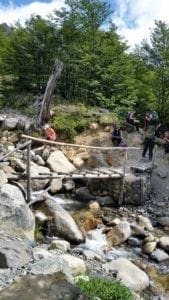
Long hikes can range from one hour to over 12 hours (if you’re at your training peak).
If you’re new to hiking, start with one hour to get a feel for your pace – that is, how many miles you can comfortably hike in an hour.
This will help you plan your future training. Increase your long hike by no more than 25% each week to prevent injury.
If possible, do your long hikes on trails that motivate you. Do some research and come up with some local trails for your training.
PACE YOURSELF TO BURN MORE FAT
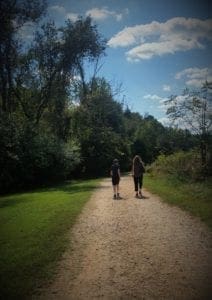
Hiking at low intensity burns the most fat.
Low intensity means you can breathe easily through your nose and carry on a conversation.
Hiking faster could put you in the cardio zone where you’re going too fast to burn fat and too slow to get any aerobic benefits.
Wear a heart rate monitor or use the built-in monitors in your machine to gauge intensity.
Your aerobic (fat-burning) zone will generally be between 60–75 percent of your max heart rate.
INDOOR TRAINING DURING THE WEEK
Unless you’re a Park Ranger, you probably won’t be able to hike and climb outdoors every day. That’s all right – there are ways to train indoors until you can get out there.
WEIGHT TRAINING FOR HIKING
Lifting weights or your own body weight for Strength training is beneficial for all hikers and climbers, and it’s especially helpful if you want to lose weight.
Muscle is an excellent fat burner.
There’s no magic program you need to follow. Just work your major muscle groups 2-3 times per week, including your core.
CARDIO ENDURANCE FOR HIKERS
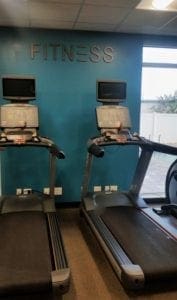
The best way to prepare for a hiking trip is, of course, hiking.
When you can’t do that, there are some cardio exercises you can do in a gym to get you ready for the trail.
When you are hiking or backpacking, along with carrying the extra weight of your pack you will have elevation gain and loss that will quickly raise your heart rate.
These exercises attempt to simulate those conditions.
The best cardio endurance exercises for hikers are weight bearing (on your feet) and force you to step uphill. For extra resistance, wear a backpack or weights.
Here are some examples of indoor cardio endurance workouts:
1. HIKING ON A TREADMILL

Adjusting the treadmill to an appropriate speed and steeper incline simulate the steep elevation you might have on your hike.
This exercise will allow you to build up stamina so that you can crank out those miles when you’re on the trail.
2. STAIRCLIMBER CONDITIONING FOR HIKING

The stair climber is one of the best cardio machines in a gym, and will literally kick your butt!
For an extra bonus, you can do this exercise wearing your pack.
Start out at a slow pace to get your rhythm and then speed it up a bit. Start with 20 mins and build up.
3. WALKING LUNGES
Walking lunges will hit almost all of the muscles in your legs and glutes.

Combining this with walking will increase balance and ankle stability, which is very important when hiking in rough terrain.
Doing 3 sets of 15 reps will be a good start.
When you feel comfortable add weight by carrying dumbbells in each hand.
Increase weights to get a harder workout.
4. Jogging

Jogging on a treadmill at a moderate pace is good exercise to prepare for hiking, too.
You can set an incline or a hills program to simulate outdoor terrain.
Better yet, take it outside.
Run at a moderate pace to build muscle and endurance.
Get the Best Hiking Gear
One of the best things about hiking for weight loss is that it’s inexpensive. In fact, you can start with very little gear, a lot of which you pick up secondhand.
Here are the hiking essentials I recommend for beginners:

Boots: To enjoy hiking, you’ve got to be good to your feet! Shop for comfort, ankle support, and water resistance. Your boot should also have a grippy sole for slick surfaces.
Learn about how to choose the best boots here.
Socks: Invest in some good wool or synthetic hiking socks; I actually layer one thin pair under a thicker pair.

Backpack: For short hikes, just about any comfy pack will do.
If you’re going into the backcountry, shoot for one with a capacity of about 35L with plenty of padding, ventilation, and a hip belt.
Appropriate Clothing: Your hiking clothes should be made out of synthetic material that will dry quickly if you’re sweating or caught in the rain.
Need more ideas? Check out my Gear page to see more.
I hope you’ve found this post helpful in starting your Spring training. Leave a comment about your training experience, or if you have a question drop me a note.
Thanks for stopping by – see you next time! LJ
To Get New Idratherwalk Posts
sent directly to your inbox (how convenient!) Click this Button
If you like this post, please share it!
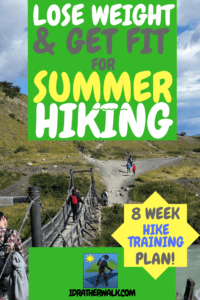
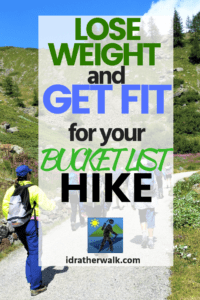

LJ has spent much of her free time as a single Mom – and now as an empty-nester – hiking in the US and around the world. She shares lessons learned from adventures both local and in exotic locations, and tips on how to be active with asthma, plus travel, gear, and hike planning advice for parents hiking with kids and beginners of all ages. Read more on the About page.

